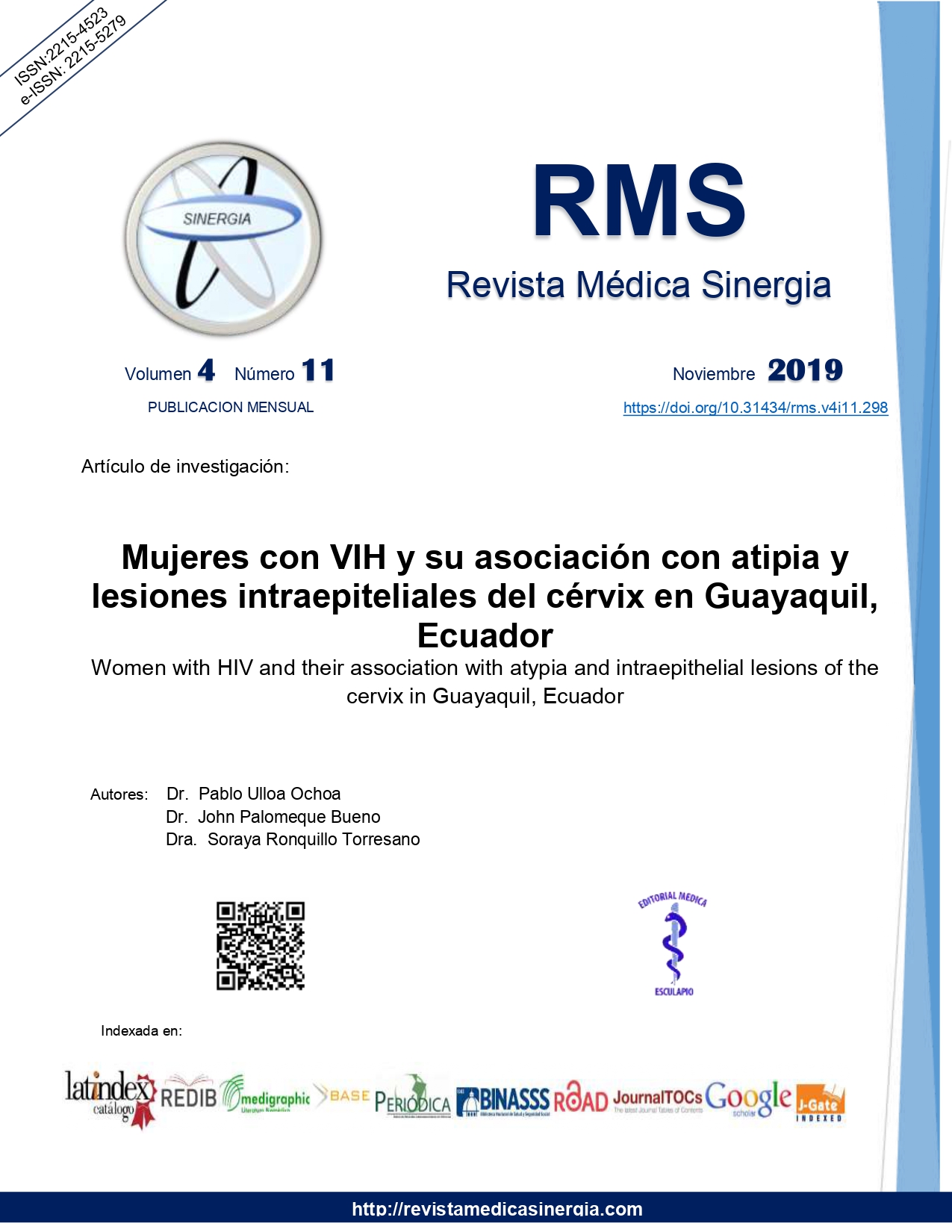Abstract
Background: ASC - US referred to the presence of atypical squamous cells of importance not determined given that p ou can progress to squamous intraepithelial lesions and carcinoma of the cervix, its link to HIV is the subject of analysis. The objective is to determine the association of intraepithelial lesions in seropositive patients. Methods: It was performed studio, descriptive, retrospective at the Infectious Diseases Hospital José Daniel Rodríguez Maridueña in 32 women with a diagnosis of atypical cell by Pap test, from January 2013 to March 2016. They are variables of age, tested seropositive HIV seronegative HIV, cytologic result. Results: Within the first group (seropositive) 71% had viral load less than 20, the value of CD4 was greater than 500 43%, before surgery the largest retroviral scheme used was (TDF + FTC + EFV ) With 50% of the patients, in regard to previous vaginal cytology, it was identified that ASCUS led with 71%, the only patient who presented high-grade LIE was one of those with the highest viral load. The 18 72% seronegative patients presented ASCUS, 3 LIE BG, 2 LIE AG and no carcinoma. Conclusion: We conclude indicating that the most frequent cytological report is ASCUS, the prevalence of cervical carcinoma in situ was zero, that intraepithelial lesions of low grade and high grade can be related to a decrease in CD4 and increased the viral of the load.
Keywords
References
AIDSinfo [internet]. Geneva: Joint United Nations Programme on HIV/AIDS (UNAIDS); 2017 March 30 [cited 2018 March 30] Available from: http://aidsinfo.unaids.org
HIV/AIDS [internet]. Global Health Observatory (GHO) data. Geneva: World Health Organization; 2018 April 12 [cited 2018 April 12] Available from: http://www.who.int/ gho/hiv/en/
Bray F, Ferlay J, Soerjomataram I, Siegel RL, Torre LA, Jemal A. Global cancer statistics 2018: GLOBOCAN estimates of incidence and mortality worldwide for 36 cancers in 185 countries. CA: A Cancer Journal for Clinicians. 2018 09 12;68(6):394-424. https://doi.org/10.3322/caac.21492
ACOG Practice Bulletin No. 109: Cervical Cytology Screening. Obstetrics & Gynecology. 2009 Dec;114(6):1409-1420. https://doi.org/10.1097/aog.0b013e3181c6f8a4
United Nations Programme on HIV/AIDS (UNAIDS). Ending AIDS. Progress towards the 90–90–90 targets [Internet] 2017 [Cited 12 April 2018]; Available from: http://www.unaids.org/sites/default/files/media_asset/Global_AIDS_update_2017_en.pdf
ACOG Practice Bulletin No. 99: Management of Abnormal Cervical Cytology and Histology. Obstetrics & Gynecology. 2008 Dec;112(6):1419-1444. https://doi.org/10.1097/aog.0b013e318192497c
Committee Opinion No. 463: Cervical Cancer in Adolescents: Screening, Evaluation, and Management. Obstetrics & Gynecology. 2010 08;116(2, Part 1):469-472. https://doi.org/10.1097/aog.0b013e3181eeb30f
Noller KL. Intraepithelial neoplasia of the lower genital tract (cervix, vulva): etiology, screening, diagnostic techniques, management. In: Lentz GM, Lobo RA, Gershenson DM, Katz VL, eds. Comprehensive Gynecology. 6th ed. Philadelphia, PA: Elsevier Mosby; 2012:chap 28.
Saslow D, Solomon D, Lawson HW, Killackey M, Kulasingam SL, Cain J, Garcia FAR, Moriarty AT, Waxman AG, Wilbur DC, Wentzensen N, Downs LS, Spitzer M, Moscicki A, Franco EL, Stoler MH, Schiffman M, Castle PE, Myers ER, . American Cancer Society, American Society for Colposcopy and Cervical Pathology, and American Society for Clinical Pathology screening guidelines for the prevention and early detection of cervical cancer. CA: A Cancer Journal for Clinicians. 2012 03 14;62(3):147-172. https://doi.org/10.3322/caac.21139
Branson B, Handsfield HH, Lampe MA, et al. Revised recommendations for HIV testing of adults, adolescents, and pregnant women in health - care settings. MMWR Recomm Rep 2006:55(RR - 14) ; 1-17.
Rizza SA, MacGowan RJ, Purcell DW, Branson BM, Temesgen Z. HIV Screening in the Health Care Setting: Status, Barriers, and Potential Solutions. Mayo Clinic Proceedings. 2012 09;87(9):915-924. https://doi.org/10.1016/j.mayocp.2012.06.021
CD4+ Count–Guided Interruption of Antiretroviral Treatment. New England Journal of Medicine. 2006 Nov 30;355(22):2283-2296. https://doi.org/10.1056/nejmoa062360
Krishnamurti U, Movahedi - Lankarani S, Bell DA, et al. Protocol for the Examination of Specimens from Patients with Primary Carcinoma of the Uterine Cervix. College of American Pathologists 2017.
Bhatla N, Aoki D, Sharma DN, et al. FIGO Cancer of the cervix uteri. Int J Gynecol Obstet 2018;Mar; 148(3):608 - 621.
Minion LE, Tewari KS. Cervical cancer – State of the science: From angiogenesis blockade to checkpoint inhibition. Gynecologic Oncology. 2018 03;148(3):609-621. https://doi.org/10.1016/j.ygyno.2018.01.009
Chung HC, Schellens JHM, Delord J, Perets R, Italiano A, Shapira-Frommer R, Manzuk L, Piha-Paul SA, Wang J, Zeigenfuss S, Pruitt SK, Marabelle A. Pembrolizumab treatment of advanced cervical cancer: Updated results from the phase 2 KEYNOTE-158 study.. Journal of Clinical Oncology. 2018 05 20;36(15_suppl):5522-5522. https://doi.org/10.1200/jco.2018.36.15_suppl.5522
Leal JO. "INCIDENCIA DE LA NEOPLASIA INTRAEPITELIAL CERVICAL EN EMBARAZADAS VIH POSITIVO". Ph.D. dissertation. , Universidad del Zulia; 2013.
Arias JL, Herrera MCI. Neoplasia Intraepitelial Cervical en Mujeres, [Internet]. 1 que viven con VIH/SIDA. 2016. [revised 2018-2019; cited 2019 Mar 29]. Available from: www.medicosecuador.com/julio_leon
Rodrigues BG, Holzmann APF, Santos AGP, Lima CdA, Gon, Santos SPd. Infección por el Virus del Papiloma Humano (VPH) en mujeres con VIH/SIDA. Enfermería global, 15(44), 1 - 12.
Mejia. Determinación y evaluación de prevalencia de virus de papiloma humano en mujeres viviendo con VIH. [Internet]. Guatemala: Unive. Galileo; 2016; [revised 2019; cited 2018 Nov 2]. Available from: http://biblioteca.galileo.edu/tesario/handle/123456789/469


